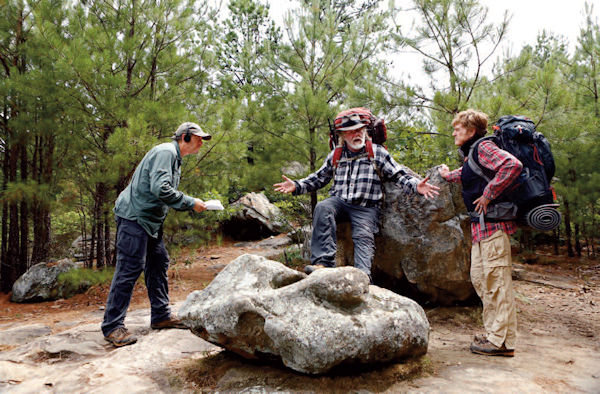SEJournal Online is the digital news magazine of the Society of Environmental Journalists. Learn more about SEJournal Online, including submission, subscription and advertising information.
Feature
By JoANN VALENTI
 |
| On the set of the new film "A Walk in the Woods" with Nick Nolte, center, and Robert Redford, right. Photo: Courtesy Sundance Film Festival |
Ordinary guys in catharsis in the forest seems to be something of a theme for notable indie movie productions this year, judging from recent screenings at the Sundance and Slamdance annual film festivals in the mountains of Utah.
For instance, movie star James Franco plays a divorced dad recovering from alcoholism who takes a hike in the national park in the film “Yosemite.” Nature is a prime setting for attempting to bond with his two sons, right before a mountain lion turns up.
Similarly, Sundance founder Robert Redford and Nick Nolte provide an insightful reminder of the impact of being in nature with “A Walk in the Woods.” Two estranged high school buddies, one an aging travel writer, decide to hike the 2000-mile Appalachian Trail in what is more than a road trip comedy but less than a family film. The two aging characters face off with each other, the wiles of nature and the eccentric characters one might encounter on such a trek, only to discover that some roads are better left untraveled.
More poignant is “Bob and the Trees.” This quasi-biopic docudrama follows a fast-talking 50-year-old logger in rural Massachusetts with an unexpected soft spot for golf and gangsta rap as he struggles to make ends meet in a logging and subsistence farming economy undergoing change. In the film, a logging job goes awry as a wooded area has been infested with ant colonies, making the trees useless for harvest, and pushing the character into depression and rage.
“Bob” is played by real-life Bob Tarasuk, a popular Berkshires forester-turned-farmer who for more than 35 years has maintained countless acres of woods there. The film’s writer-director Diego Ongaro met Tarasuk shortly after moving to the rural town of Sandisfield, Mass., from Paris. “I’ve often wondered about the history of the plank you buy at the lumberyard or the log you throw in the fireplace,” Ongaro said.
Another perspective on wood — and a tribute to the lives of trees — comes from “Trees That Walk.” The Italian-language film follows logging in that country through to final wood products, from flooring and cabinetry to museum-quality violins. Over a history of world wars, industry and environmental changes, and economic challenges a story unfolds from Italians who love trees and working with wood.
Docs explore ‘ecology movement,’ mountain climbing, Chernobyl
It was not all in the trees at January’s Sundance event. The festival’s feature documentary expanded the focus to an important slice of environmental history. “How to Change the World” looks to pre-Earth Day and Green Movement days, when environmental concerns fomented around what was then called the “ecology movement.”
Before becoming the world’s largest activist organization, Greenpeace began as an eclectic group of Vancouver neighbors — journalists, scientists and hippies — united in opposition to a U.S. atomic test on an Alaskan island. The Canadian activists sailed an aging fishing boat straight for the test site. Armed only with cameras and convinced of the power of images, the Rainbow Warriors were born.
Greenpeace’s early history stored in film footage, audio recordings and photographs capture their media savvy in its most dramatic and iconic moments. Providing images of mother seals hopelessly chasing after their clubbed pups, mass slaughter at whaling stations and maneuvering Zodiacs between whales and Russian harpoons marked the beginning of major international changes in once acceptable animal harvesting.
The documentary offers an intimate portrait of the group’s original members and of the ego struggles among activists — idealism vs. pragmatism, principle vs. compromise. Ultimately, a handful of people, including a journalist turned activist re-turned journalist, did grab the world’s attention. They just couldn’t agree on how to actually change the world.
Other documentaries and dramas on the Sundance “nature/climate change/environmental” genre list included titles on extreme mountain climbing (“Meru”), a conservationist in an Irish horror flick (“The Hallow”), eco-activists taking risks to expose illegal trading in endangered species (“Racing Extinction”), a challenged synchronized swimmer (“Chlorine”) and an extraordinary documentary about a Ukrainian artist who exposes Chernobyl as no accident (“The Russian Woodpecker”).
New ways to fund, distribute films
One subject to emerge at the festivals was that of how to get these kinds of films made in the first place. Funding independent films is getting harder at a time when financiers are after safe bets.
But a powerful, new grassroots force has emerged on sites like Indiegogo and Kickstarter. Filmmakers can now go directly to their fans to realize their creative decisions while still maintaining creative control. The challenge remains how these projects can reach an audience.
New digital distribution platforms offer some promise. For example, YouTube returned to Sundance for a third year, sponsoring panels and encouraging new filmmakers. “We are committed to actively advancing the work of innovative, risk-taking storytellers worldwide,” said Danielle Tiedt, chief marketing officer. “On YouTube, there are no limits to creative freedom, allowing creators to experiment and push the boundaries of traditional formats and mediums.”
“Change is inevitable,” indie film mentor Redford told a theater packed with reporters at the festival’s opening press conference. “We ride with change and use it to our advantage.”
SEJournal Editorial Board member JoAnn Valenti, an emerita professor and a founding academic member of SEJ, covers environment/science/health films at Sundance and other film festivals for several academic/professional, national and international publications. For full Sundance festival information and links to films, go to www.sundance.org.
* From the quarterly newsletter SEJournal, Spring 2015. Each new issue of SEJournal is available to members and subscribers only; find subscription information here or learn how to join SEJ. Past issues are archived for the public here.













 Advertisement
Advertisement 



